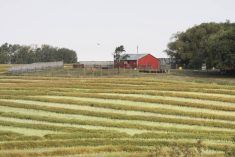Alberta’s cities have an insatiable appetite for farmland, a recent study from the Alberta Land Institute reveals.
In the Edmonton-Calgary corridor, urban development had swallowed 4,763 sq. kilometres of land as of 2013, a 52 percent increase from 1984, when the figure was 3,127 sq. km.
In that same period, Calgary’s urban area expanded to 754 sq. km from 242 sq. km in 1984.
Most of the land developed around cities from 2000-12 was prime cropland.
The figures were compiled by University of Alberta faculty members Brent Swallow and Scott Jeffrey.
Read Also

Nutritious pork packed with vitamins, essential minerals
Recipes for pork
“We were interested to see our results about prime farmland, the highest quality farmland, that there is really this strong footprint between where we’re growing our populations and where the prime farmland is in Alberta,” Swallow said.
“It is sort of a fact that we’re sitting, especially here in Edmonton, in an area of lots of prime agricultural land, so the growth in this area almost by definition is going to grow into areas of high quality farmland.”
The study showed that Calgary has an urban density three times higher than Edmonton, which is sprawling outward into land more suited to agricultural than is the land around Calgary.
An increase in the number of acreages on the outskirts of Alberta’s two largest cities was also evident in the study, which has implications for future development, said Swallow.
“Fragmentation tends to be kind of a precursor to conversion of land into developed uses,” he said.
“We found kind of a complicated … relationship with fragmentation, and fragmentation we think is mostly caused by the development of acreages in rural residential areas. And that’s really strong around the two cities, Edmonton and Calgary.
“It’s really, really noticeable around Calgary and along the kind of corridor area that joins the two cities.”
Another surprise for Swallow was the concern about farmland conservation shown by 320 respondents in a survey conducted as part of the study.
They were asked how much they would be willing to pay, in a one-time contribution, toward farmland conservation in the Edmonton region.
There is no financial mechanism to actually do that, but Swallow said asking people to put a dollar figure on something is a good way to determine what they really value.
About 80 percent of respondents said they’d be willing to make a small financial contribution, and more than 50 percent said they’d be willing to give $300.
“I was pretty surprised with the awareness and the interest of urban residents of the capital region and their interest in the issues of farmland conversion and fragmentation and in preservation of farmland and their expressed interest of why they’re interested in conserving farmland,” said Swallow.
Respondents showed the most concern about preserving farmland for local food production, such as market gardens and vegetables sold at farmers markets. They were less interested in production of food for global markets.
However, respondents were also aware that land conservation is important to air and water quality as well as landscape beauty.
Farmers and ranchers were interviewed separately for the study, while the survey sought to achieve a representative sample of the population in and around Edmonton.
Swallow said the study results could be useful to municipalities as they plan future development. The new Municipal Government Act, passed last year, specifically calls upon municipalities to conserve prime farmland and make plans in conjunction with neighbouring municipalities.
“We think that one of the causes of an over-allocation of land into developed uses and out of agriculture is due to sort of a grab for tax base,” said Swallow.
If neighbouring municipalities could make their plans together, the impact on farmland might be reduced.
The Calgary and Edmonton metropolitan areas had the highest rate of population growth among all Canadian cities from 2006-16.


















